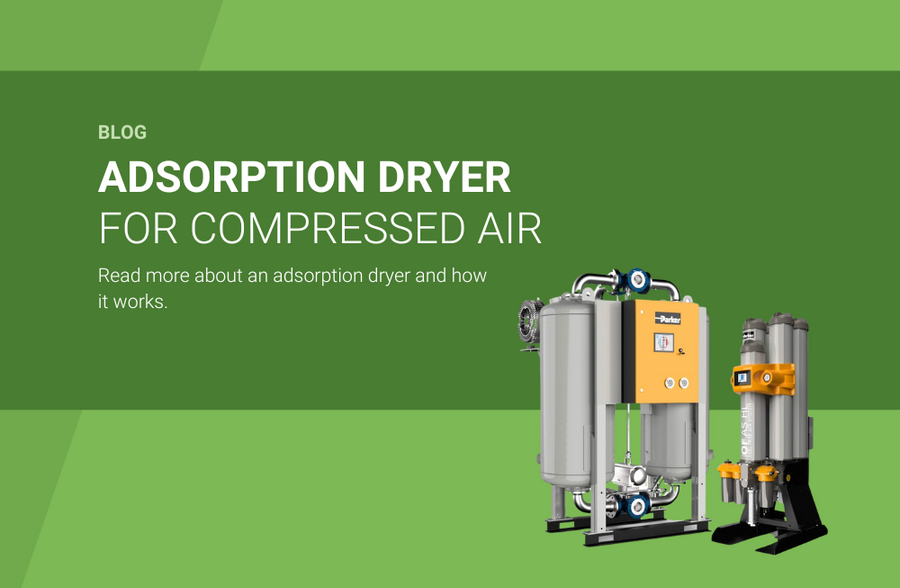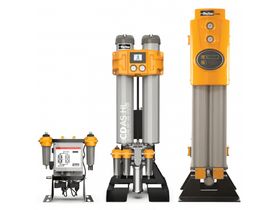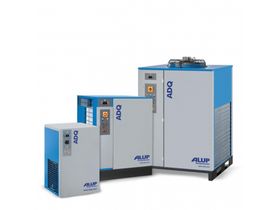
Compressed air is an essential part of many production processes. However, compressed air can contain a lot of moisture. Did you know that standard dried compressed air using a refrigeration dryer still contains about 6 grams of moisture per m³? For many applications, this is not workable, as moisture can still accumulate in pipelines and cause corrosion, leading to costly damage and inefficiency. In many cases, an adsorption dryer is a better solution, especially in critical applications such as the use of compressed air (and nitrogen) in the food or pharmaceutical industry. In this blog, we will explain how adsorption dryers work and why they are a crucial component for achieving the right compressed air quality.
What is an adsorption dryer?
An adsorption dryer is a compressed air dryer that uses adsorption technology. Unlike a refrigeration dryer, air can be dried further to a pressure dew point of -40 to even -70°C, meaning the air is extremely dry. The international standard ISO 8573-1:2010 specifies the allowable levels of moisture, particles, and oil (vapor)/hydrocarbons in the air. Adsorption dryers can achieve a pressure dew point ("Pressure Dew Point," PDP) of up to -70°C, which corresponds to the highest class, also known as Class 1.

How does an adsorption dryer work?
An adsorption dryer consists of at least two columns filled with adsorption granules, sometimes in different compositions, allowing CO2 to be absorbed as well. Adsorption granules attract and retain moisture. The process of an adsorption dryer works as follows:
- Drying: The compressed air flows through one of the columns, where the granules adsorb the moisture.
- Regeneration: Once the granules are saturated, the airflow is redirected to the second column. Meanwhile, the pressure in the first column is released, and the granules are regenerated.
This cyclic process is known as "Pressure Swing Adsorption" (PSA). This ensures that one column is always actively drying while the other is being cleaned and restored.
Applications of adsorption dryers
Adsorption dryers are essential in situations where high compressed air quality is required. They are also crucial for compressed air pipelines or control valves that could freeze in winter due to condensed moisture. By delivering dry air, adsorption dryers help prevent many issues.
The following industries make use of adsorption dryers:
- Food and beverage industry: Ensuring food-safe air where moisture must not create a breeding ground for bacteria and mold. This extends product shelf life and prevents contamination.
- Pharmaceutical industry: Providing sterile and dry air that meets the strictest hygiene standards.
- Metalworking and pneumatic systems: Preventing corrosion in steel pipelines and sensitive equipment.
Adsorption dryer vs. refrigeration dryer
When selecting the right compressed air dryer, we consider the required compressed air class and the desired pressure dew point. For applications requiring Class 1 to 3, with a pressure dew point of -20°C, -40°C, or even -70°C, we recommend an adsorption dryer. When a pressure dew point of +3°C is sufficient, fitting Class 4 to 5, a refrigeration dryer is the best choice.
In some cases, combining a refrigeration dryer with an adsorption dryer can lead to significant energy savings. The ATT (Antares) 040-340 series from Parker offers this combination in one efficient unit. This series has a capacity of up to 2040 m³/hour and can achieve dew points ranging from +5°C to -70°C, ensuring flexible and reliable air treatment.
Which adsorption dryer suits your application?
When choosing an adsorption dryer, the required compressed air class and flow rate must be considered. Parker offers a wide range of adsorption dryers, including:
![]()
- K-MT & KA-MT series: Compact dryers for small to medium applications.
- CDAS and OFAS series: Adsorption dryers that can optionally be equipped with an activated carbon column for oil-free compressed air.
- KE-MT series: Suitable for applications with a flow rate of up to 6100 m³/h.
- WVM series: Heat-regenerated dryers with a flow rate of up to 14,500 m³/h, ideal for industrial applications with up to 25% energy savings.
- Antares series: An innovative combination of refrigeration and adsorption drying for efficient air treatment.
Need free advice on adsorption dryers?
At Avilo, we are happy to help you find the right solution for your specific situation. Would you like more information or free advice on adsorption dryers? Feel free to contact us.
 EN
EN
 NL
NL




